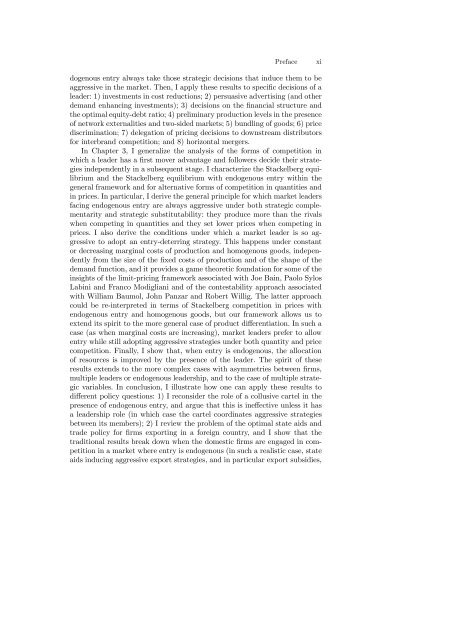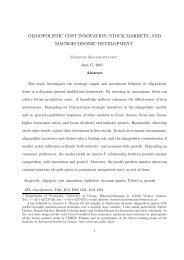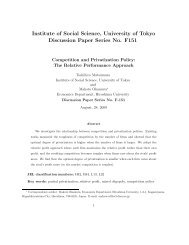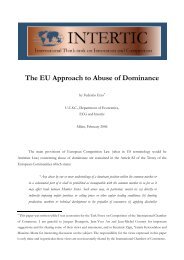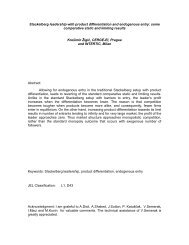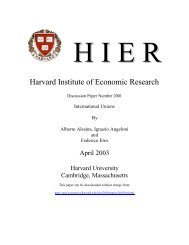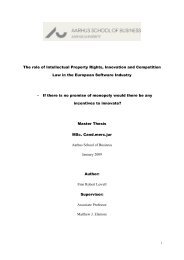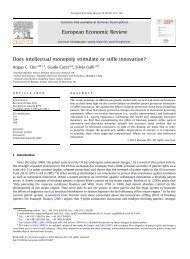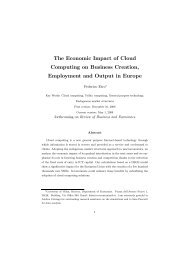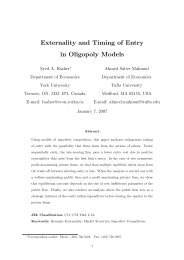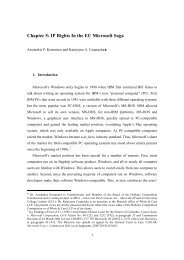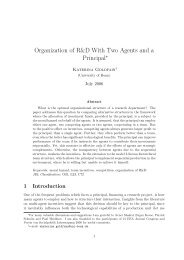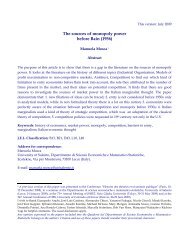Competition, Innovation, and Antitrust. A Theory of Market ... - Intertic
Competition, Innovation, and Antitrust. A Theory of Market ... - Intertic
Competition, Innovation, and Antitrust. A Theory of Market ... - Intertic
You also want an ePaper? Increase the reach of your titles
YUMPU automatically turns print PDFs into web optimized ePapers that Google loves.
Preface<br />
xi<br />
dogenous entry always take those strategic decisions that induce them to be<br />
aggressive in the market. Then, I apply these results to specific decisions <strong>of</strong> a<br />
leader: 1) investments in cost reductions; 2) persuasive advertising (<strong>and</strong> other<br />
dem<strong>and</strong> enhancing investments); 3) decisions on the financial structure <strong>and</strong><br />
the optimal equity-debt ratio; 4) preliminary production levels in the presence<br />
<strong>of</strong> network externalities <strong>and</strong> two-sided markets; 5) bundling <strong>of</strong> goods; 6) price<br />
discrimination; 7) delegation <strong>of</strong> pricing decisions to downstream distributors<br />
for interbr<strong>and</strong> competition; <strong>and</strong> 8) horizontal mergers.<br />
In Chapter 3, I generalize the analysis <strong>of</strong> the forms <strong>of</strong> competition in<br />
which a leader has a first mover advantage <strong>and</strong> followers decide their strategies<br />
independently in a subsequent stage. I characterize the Stackelberg equilibrium<br />
<strong>and</strong> the Stackelberg equilibrium with endogenous entry within the<br />
general framework <strong>and</strong> for alternative forms <strong>of</strong> competition in quantities <strong>and</strong><br />
in prices. In particular, I derive the general principle for which market leaders<br />
facing endogenous entry are always aggressive under both strategic complementarity<br />
<strong>and</strong> strategic substitutability: they produce more than the rivals<br />
when competing in quantities <strong>and</strong> they set lower prices when competing in<br />
prices. I also derive the conditions under which a market leader is so aggressive<br />
to adopt an entry-deterring strategy. This happens under constant<br />
or decreasing marginal costs <strong>of</strong> production <strong>and</strong> homogenous goods, independently<br />
from the size <strong>of</strong> the fixed costs <strong>of</strong> production <strong>and</strong> <strong>of</strong> the shape <strong>of</strong> the<br />
dem<strong>and</strong> function, <strong>and</strong> it provides a game theoretic foundation for some <strong>of</strong> the<br />
insights <strong>of</strong> the limit-pricing framework associated with Joe Bain, Paolo Sylos<br />
Labini <strong>and</strong> Franco Modigliani <strong>and</strong> <strong>of</strong> the contestability approach associated<br />
with William Baumol, John Panzar <strong>and</strong> Robert Willig. The latter approach<br />
could be re-interpreted in terms <strong>of</strong> Stackelberg competition in prices with<br />
endogenous entry <strong>and</strong> homogenous goods, but our framework allows us to<br />
extend its spirit to the more general case <strong>of</strong> product differentiation. In such a<br />
case (as when marginal costs are increasing), market leaders prefer to allow<br />
entry while still adopting aggressive strategies under both quantity <strong>and</strong> price<br />
competition. Finally, I show that, when entry is endogenous, the allocation<br />
<strong>of</strong> resources is improved by the presence <strong>of</strong> the leader. The spirit <strong>of</strong> these<br />
results extends to the more complex cases with asymmetries between firms,<br />
multiple leaders or endogenous leadership, <strong>and</strong> to the case <strong>of</strong> multiple strategic<br />
variables. In conclusion, I illustrate how one can apply these results to<br />
differentpolicyquestions:1)Ireconsider the role <strong>of</strong> a collusive cartel in the<br />
presence <strong>of</strong> endogenous entry, <strong>and</strong> argue that this is ineffective unless it has<br />
a leadership role (in which case the cartel coordinates aggressive strategies<br />
between its members); 2) I review the problem <strong>of</strong> the optimal state aids <strong>and</strong><br />
trade policy for firms exporting in a foreign country, <strong>and</strong> I show that the<br />
traditional results break down when the domestic firms are engaged in competition<br />
in a market where entry is endogenous (in such a realistic case, state<br />
aids inducing aggressive export strategies, <strong>and</strong> in particular export subsidies,


